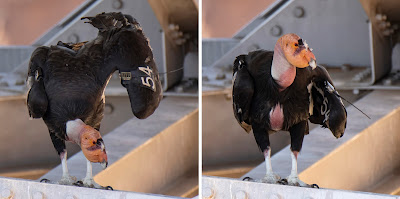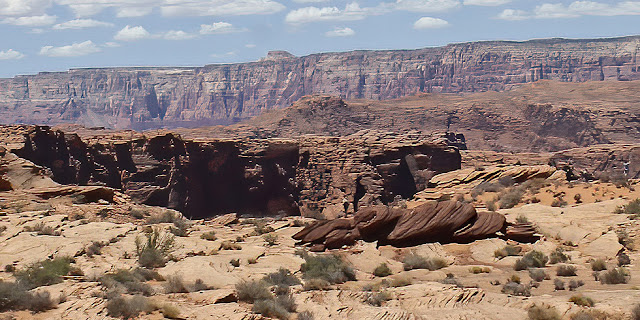 |
| Made it! |
Caty hadn’t been there since she was three, so she has no memory of it.
I don’t really have a strong memory of that trip, either.
I rode up from Phoenix, where we lived, to the South Rim with Scott’s cousin’s wife to pick up our car and drive it 215 miles to the North Rim. Scott, his cousin and a couple of other guys were doing a Rim-to-Rim hike (South to North, which is the opposite of the way must people do it). I was providing transportation services.
I was barely pregnant (and, thus, not feeling well) and I had a toddler in tow. We just stayed one night and came home, so it wasn’t very memorable.
 |
| Scott at the bottom of the Canyon, 1985 |
But, I have been back since and it is lovely, indeed.
The North Rim is cooler and greener than the South Rim and far, far less crowded.
Because of its remoteness and its penchant for heavy winter snow, the North Rim is open only from May 15 to October 15 each year. The South Rim is open all year. About 5.9 million people visited the Grand Canyon last year; only 1 million (still a lot!) went to the North Rim.
The South Rim is three and a half hours from Phoenix and four from Las Vegas. The North Rim is from almost six hours from Phoenix and four and a half from Las Vegas. As a result, the North Rim is calmer and more relaxed.
 |
| The Grand Canyon Lodge, North Rim |
Caty and I stayed in a Pioneer Cabin, which is usually where I stay. Older and smaller than the newer Frontier Cabins, they are also more affordable.
I must admit that we didn’t really do much while at the North Rim (we were there two nights and only one full day).
We explored all the overlooks, enjoying the pretty (although very hazy) scenery.
 |
| Too many fires in the area |
 |
| Moon drive |
We walked a lot of the Rim trails and overlooks, but didn’t embark on any serious hikes.
It was cool in the evening, but a bit warm during the day (of course, the South Rim would have been much hotter).
We looked for birds and animals, but didn’t see much. We didn’t even see the Bison herd that normally hangs out near the entrance.
 |
| CW: Common Raven, Western Tanager, House Wren, Cliff Chipmunk, Hayden's Grasshopper |
 |
| The view outshines the food |
The food was fine, but not really special. And, the plasticware kind of ruined the ambiance. But, the view was incomparable.
Maybe we should have gotten a pizza (the North Rim has a pretty good pizzeria) and sat on the balcony to watch sunset.
 |
| End of day |
It was a pretty and somewhat restful stop.
But, we had more to see.
Navajo Bridge and Lee's Ferry
Our final Arizona stop was Navajo Bridge with hopes of seeing some Condors. We stopped by the Bridge several times and were rewarded on two visits.
Actually, it’s two Bridges: one carries automobile traffic over the river and the other, older bridge, is only open to foot traffic.
The dual spans of Navajo Bridge are tied at ninth place among the highest bridges in the United States with nearly identical heights of 467 feet for the original span built in 1929 and 470 feet for the second span built in 1995.
We stayed one night at the Lee’s Ferry Lodge at Vermilion Cliffs, just down the road from Navajo Bridge, which is in Marble Canyon (the hotel there was booked). It was a nice room in the middle of nowhere.
It was beastly hot in the daytime and a pool sure would have been nice. But, it was fairly convenient, especially because we went out one night and did some night sky photography. The weather was great for that!
Plus, it is a stunningly beautiful area at the base of the Vermilion Cliffs, one of Arizona's many striking landscapes (and skyscapes).
And, Lee's Ferry provides some interesting scenery, as well.
We could have easily stayed in Page for all our visits (even the North Rim, but that wouldn’t have given us much actual Canyon time), but it was much more convenient to pop down the road a few miles to shoot the stars …
… and the bridge …
... and the scenery ...
… and the Condors!
 |
| The largest bird in North America |
California Condors
I have been to Navajo Bridge before. Heck, I’ve even drifted below it on a raft after launching from Lee’s Ferry for our trip through the Grand Canyon.
But, even though this is the most reliable place to see California Condors, I hadn’t seen them there before.
I had seen several from the South Rim and one on our rafting trip. And, yes, I have written about them before.
Caty hadn’t ever seen one, so this was a treat. We saw three.
 |
| Obvious transmitters |
We were able to look up the birds we saw on The Peregrine Fund’s website.
The Peregrine Fund has been breeding California Condors since 1993 at its facility, The World Center for Birds of Prey, in Boise, Idaho. Once the birds are big enough, they are released in Arizona, California or Baja Mexico. They have been releasing condors near Navajo Bridge since 1996.
We saw #354 (marked with a big 54) first. He was sitting on the supports below the newer of the two side-by-side bridges over the Colorado River.
Born in captivity at the World Center in Boise on June 13, 2004, #354 was released March 2, 2006.
 |
| Showing off his tag |
Later, we saw #930 (marked for reasons I do not understand as X0).
 |
| Sitting across the chasm |
Also a male, he was born April 25, 2018, also at the World Center in Boise. He was released on Oct. 30, 2019.
 |
| A strong flyer |
You might notice that these two birds look different. That’s because #354 is, at 16 years old, an adult. At four, #930 (X0) is a juvenile.
 |
| Adult #354, left; Juvenile #930, right |
While watching the Condors, we saw them fly multiple times.
Once #930 flew across the Bridge less than ten feet off the ground and probably less than eight feet in front of a man who had just stepped from the parking lot onto the Bridge. He didn’t even know there were Condors around, so you can imagine his shock. I just wish I had gotten a photo of his expression. It was priceless.
At one point #354 ran #930 off, so there may be a little territory conflict.
We talked to a woman who was carrying an antenna to monitor the Condors (which gave her a great deal of credibility) and she pointed out a nest on the cliff wall not too far from the old Bridge (extra credibility). The nest is in a cleft in the rock and, although we watched and stopped twice, we never saw the Condor chick. One born in the wild would be a treat to see.
We did, however, see an adult sitting near the nest (our third bird). He was #619 (marked 19), another male born at the World Center in Boise. He was born May 3, 2011, and released Dec. 7, 2012.
I am not sure if #619 is one of the parents, although I assume he is. However, I saw a reference to #354 and Condor #496 using a “close to the Bridge” nesting site several years ago. I couldn’t tell from the photo whether it was the same site or not. California Condors are monogamous and mate for life. I do not know if #354 has a nest this year.
The woman expert we met also told us that the Condors tend to get active around 10 a.m., which proved true when we were there. Before talking to her, we had assumed that you needed to get there early to see them.
All the birds we saw were born and hand-raised at the World Center for Birds of Prey, which was built in 1984 and is the headquarters for The Peregrine Fund, an international non-profit organization founded in 1970 that conserves endangered raptors around the world.
The organization's first recovery effort focused on the Peregrine Falcon (no surprise there), which was facing extinction due to the widespread use of the chemical DDT. The Peregrine Fund's original breeding facilities were established at Cornell University in central New York state in 1970 and at a Colorado Division of Wildlife facility in Fort Collins in 1974. They were moved to Boise in 1984. The first of three California Condor breeding barns was constructed in 1993.
The organization currently breeds the endangered California Condor and Aplomado Falcon.
 |
| From below |
Although, they are so big, they are hard to miss, unless they are tucked completely below the Bridge.
I think we would have stayed longer and observed the Condors more – maybe even waiting long enough to see a chick. But, it was brutally hot under the Arizona sun on that Bridge.
 |
| It's a bit cooler underneath |
Plus, how many Condor photos does one really need?




































































